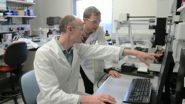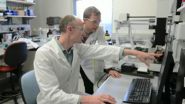(Press-News.org) VIDEO:
Melbourne researchers are homing in on a new target for malaria treatment, after developing a compound that blocks the action of a key 'gatekeeper' enzyme essential for malaria parasite survival.
The...
Click here for more information.
Melbourne researchers are homing in on a new target for malaria treatment, after developing a compound that blocks the action of a key 'gatekeeper' enzyme essential for malaria parasite survival.
The compound, called WEHI-916, is the first step toward a new class of antimalarial drugs that could cure and prevent malaria infections caused by all species of the parasite, including those resistant to existing drugs.
Scientists at the Walter and Eliza Hall Institute developed WEHI-916 to block the critical malaria enzyme Plasmepsin V. The research team has previously shown Plasmepsin V is a 'gatekeeper' enzyme responsible for controlling the transport of critical proteins in and out of the parasite.
Dr Brad Sleebs, Dr Justin Boddey, Mr Sash Lopaticki, Mr Matthew O'Neill, Professor Alan Cowman and colleagues from the Walter and Eliza Hall Institute published their findings today in PLOS Biology.
Dr Boddey said the research team used WEHI-916 to prove the importance of Plasmepsin V to malaria parasite survival. "In this study, we developed a novel compound to target Plasmepsin V and showed for the first time that the enzyme is essential for survival of the malaria parasite" he said. "WEHI-916 is really exciting because if you block Plasmepsin V, the malaria parasite dies."
Plasmepsin V was an ideal drug target because its inhibition effectively halted the transport of hundreds of malaria proteins, Dr Boddey said. "The Plasmodium parasite needs to produce and deliver over 300 different proteins to the red blood cell to survive in the body and hide from the host's immune system," he said. "Instead of targeting individual proteins, we can block Plasmepsin V and prevent all of those proteins from leaving the parasite."
Dr Sleebs said WEHI-916 could lead to drugs that were effective in curing malaria caused by all five species of Plasmodium parasite that cause malaria. "Of the five malaria species, Plasmodium falciparum is responsible for the most deaths and is highly prevalent in Africa, while Plasmodium vivax presents major health issues for the Asia-Pacific region," he said. "Our study has shown that Plasmepsin V is a key enzyme in these two important species of the parasite and WEHI-916 can inhibit Plasmepsin V isolated from both of them. Not only does this compound enable us to prove Plasmepsin V is an excellent drug target, it is a starting point for a research program that could lead to a new class of antimalarial drugs."
Dr Boddey said WEHI-916 was a crucial tool in proving Plasmepsin V's importance. "Researchers – including us – had been trying without success to learn more about Plasmepsin V using standard genetic techniques," he said. "Our idea was to create a drug-like compound that would block Plasmepsin V so we could investigate its importance. We found that blocking Plasmepsin V kills malaria parasites and delivered a new and effective potential drug at the same time."
Approximately half of the world's population is at risk of contracting malaria each year, with more than 200 million people infected. Malaria kills up to 700,000 people each year, predominantly children under the age of five. Current antimalarial drugs are becoming less effective as the parasite develops resistance to the drugs, making the search for new targets that can kill all species of malaria critical.
Institute scientists will now turn their attention to developing WEHI-916 and related compounds for human use, Dr Boddey said. "We are now examining in our insectary whether Plasmepsin V could be a target during other stages of the malaria lifecycle," Dr Boddey said. "The enzyme is present in the parasites that first infect humans in the liver, as well as in parasite forms that exit humans and infect mosquitoes. If WEHI-916 kills the parasite during these stages as well, it will mean any drugs that target Plasmepsin V can be used as a preventative as well as a cure."
INFORMATION:
The research was supported by the Australian National Health and Medical Research Council, the Human Frontiers Science Program, the Australian Research Council, the CASS Foundation, the Ramaciotti Foundation, Howard Hughes Medical Institute and the Victorian Government.
New compound blocks 'gatekeeper' enzyme to kill malaria
2014-07-01
ELSE PRESS RELEASES FROM THIS DATE:
Analysis of the Chinese facial profile: Contours of the side face in the Tu and Zang ethnic minorities
2014-07-01
Li Haijun and fellow researchers at Minzu University of China, in Beijing, conducted a series of geometric morphometric analyses of the contours of the side face and variations in the Tu and Zang (Tibetan) ethnic minorities from Qinghai Province, in northwestern China.
Their study, entitled "Morphometric analysis of the Chinese facial profile: Contours of the side face and variations in the Tu and Zang ethnic minorities", was published (in Chinese) in the Chinese Science Bulletin, 2014, Vol 59(16).
The team of researchers used advanced digital cameras and image processing ...
Behind a marine creature's bright green fluorescent glow
2014-07-01
Pushing closer to understanding the mechanisms behind the mysterious glow of light produced naturally by certain animals, scientists at Scripps Institution of Oceanography at UC San Diego have deciphered the structural components related to fluorescence brightness in a primitive sea creature.
In a study published in Scientific Reports, an open-access journal of the Nature Publishing Group, Dimitri Deheyn and his colleagues at Scripps Oceanography, the Air Force Research Laboratory, and the Salk Institute for Biological Studies have conducted the most detailed examination ...
Solar panels light the way from carbon dioxide to fuel
2014-07-01
Research to curb global warming caused by rising levels of atmospheric greenhouse gases, such as carbon dioxide, usually involves three areas: Developing alternative energy sources, capturing and storing greenhouse gases, and repurposing excess greenhouse gases. Drawing on two of these approaches, researchers in the laboratory of Andrew Bocarsly, a Princeton professor of chemistry, collaborated with start-up company Liquid Light Inc. of Monmouth Junction, N.J. to devise an efficient method for harnessing sunlight to convert carbon dioxide into a potential alternative fuel ...
Poor physical, financial health driven by same factors
2014-07-01
Poor physical health and financial health are driven by the same underlying psychological factors, finds a new study out of the Olin Business School at Washington University in St. Louis.
Researchers Lamar Pierce, PhD, associate professor of strategy at Olin and PhD-candidate Timothy Gubler found that the decision to contribute to a 401(k) retirement plan predicted whether or not an individual will act to correct poor physical health indicators revealed during an employer-sponsored health examination.
"We find that existing retirement contribution patterns and future ...
Blind lead the way in brave new world of tactile technology
2014-07-01
Imagine feeling a slimy jellyfish, a prickly cactus or map directions on your iPad mini Retina display, because that's where tactile technology is headed. But you'll need more than just an index finger to feel your way around.
New research at UC Berkeley has found that people are better and faster at navigating tactile technology when using both hands and several fingers. Moreover, blind people in the study outmaneuvered their sighted counterparts – especially when using both hands and several fingers – possibly because they've developed superior cognitive strategies ...
Engaging parents, community to map student success in South King County
2014-07-01
If we had a road map to what parental involvement in schools should be, what would it look like? Would it be a straight line, or a complicated maze of cross streets going in every direction?
University of Washington researchers studied The Road Map Project, a collaborative effort to dramatically improve student achievement in seven school districts in South Seattle and South King County. In their report after a yearlong study of the initiative, they found that students were most successful when schools and communities found creative and culturally responsive ways of engaging ...
For cancer patients, sugar-coated cells are deadly
2014-07-01
ITHACA, N.Y. – Every living cell's surface has a protein-embedded membrane that's covered in polysaccharide chains – a literal sugar coating. A new study by a Cornell University researcher found this coating is especially thick and pronounced on cancer cells and is a crucial determinant of the cell's survival.
Consisting of long, sugar-decorated molecules called glycoproteins, the coating causes physical changes in the cell membrane that make the cell better able to thrive – leading to a more lethal cancer.
Matthew Paszek, assistant professor of chemical and biomolecular ...
Clemson scientists: Kudzu can release soil carbon, accelerate global warming
2014-07-01
CLEMSON, S.C. — Clemson University scientists are shedding new light on how invasion by exotic plant species affects the ability of soil to store greenhouse gases. The research could have far-reaching implications for how we manage agricultural land and native ecosystems.
In a paper published in the scientific journal New Phytologist, plant ecologist Nishanth Tharayil and graduate student Mioko Tamura show that invasive plants can accelerate the greenhouse effect by releasing carbon stored in soil into the atmosphere.
Since soil stores more carbon than both the atmosphere ...
Cellular gates for sodium and calcium controlled by common element of ancient origin
2014-07-01
Researchers at Johns Hopkins have spotted a strong family trait in two distant relatives: The channels that permit entry of sodium and calcium ions into cells turn out to share similar means for regulating ion intake, they say. Both types of channels are critical to life. Having the right concentrations of sodium and calcium ions in cells enables healthy brain communication, heart contraction and many other processes. The new evidence is likely to aid development of drugs for channel-linked diseases ranging from epilepsy to heart ailments to muscle weakness.
"This discovery ...
Mayo Clinic: Proton therapy has advantages over IMRT for advanced head and neck cancers
2014-07-01
Rochester, Minn. -- A new study by radiation oncologists at Mayo Clinic comparing the world's literature on outcomes of proton beam therapy in the treatment of a variety of advanced head and neck cancers of the skull base compared to intensity modulated radiation therapy (IMRT) has found that proton beam therapy significantly improved disease free survival and tumor control when compared to IMRT. The results appear in the journal Lancet Oncology.
"We undertook a systematic review and meta-analysis to compare the clinical outcomes of patients treated with proton therapy ...




